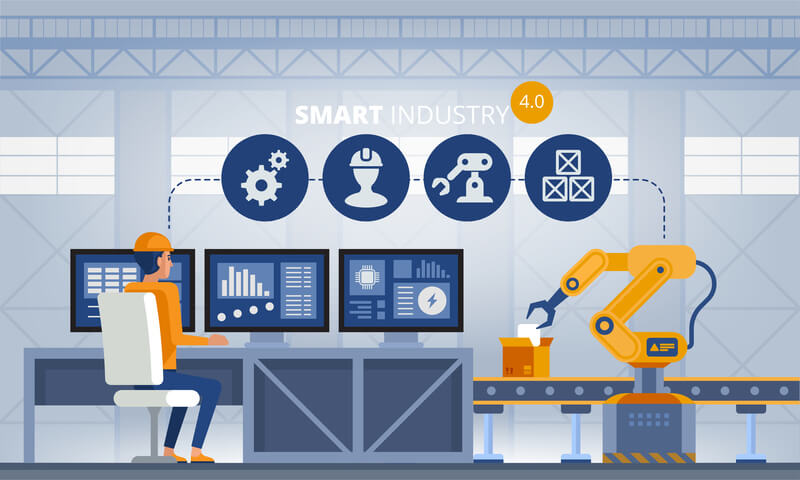Beyond the Industry 4.0 Hype: What’s In It for the SMEs?
By Tan Chiaw Hooi & Lee Ying-Han

Only 10.2% of Fortune 500 companies have remained on the list since 1955
Over the years, industries and businesses globally have been constantly disrupted, leaving no room for late adopters. The First Industrial Revolution led to the mechanisation of production from manual processes. The Second (or Technological) Revolution led to the electrification of machines for mass production. The Third (or Digital Revolution) led to automation using computers and electronics.
Now, the Fourth Industrial Revolution (commonly known as Industry 4.0) will transform how businesses operate and the way we work, led by the convergence of web connectivity and digital controls with real-world tools.
It is more important now than ever to embrace change and disruption. Today, only 51 or 10.2% of Fortune 500 companies have remained on the list since 1955 and based on the churn rate, approximately 50% of today’s S&P 500 companies may be replaced over the next 10 years.
The onset of new technologies brings transformative opportunities for today’s manufacturing and supply chain leaders to unlock unprecedented productivity and operational benefits.
Embracing Industry 4.0
The Malaysian manufacturing industry has contributed to approximately 22% of the national GDP over the last five years, with Small and Medium Enterprises (SMEs) representing 97.1% of the registered companies. However, there is a nascent intersection between Industry 4.0 and SMEs due to limited awareness.
Many SMEs are not aware that the barriers to new technologies have reduced as implementation costs have declined. With COVID-19 severely disrupting operations, coupled with new customer expectations, SMEs should reevaluate their business models and embrace digitisation to manage significant cost pressures and improve output quality, while increasing productivity, to remain competitive or speed up recovery.
Global organisations have been re-evaluating their supply chains and production geographies and relocating their operations to ASEAN. This opens up new opportunities for local businesses. However, SMEs are then confronted with a new set of challenges around production scale, rapid growth and sustainability which can be tackled by digitalisation and advanced computing capabilities.

A smart factory will utilise a multi-horizon approach to optimise, extend and transform key value chain activities to create new sources of value
Factory of the Future: Smart Factory
There is a need for an environment that facilitates interconnectivity between critical components, monitoring of the entire ecosystem and optimisation of decisions based on data from the monitoring system. This convergence of digital technologies and cognitive computing techniques is a key enabler of the Fourth Industrial Revolution, which is characterised by digitally enabled smart factories. A smart factory is defined by the co-existence of cyber-physical systems that enable ease of monitoring, experimentation, automation, and faster, more accurate decision-making.
A smart factory will utilise a multi-horizon approach to optimise, extend and transform key value chain activities to create new sources of value. Digitisation of the manufacturing system will be vital for SMEs to build direct links to end-customers and produce innovative, customised products. By fully embracing Industry 4.0, SMEs can not only overcome challenges inhibiting them today but also realise new value-creation opportunities in the future.
So, what are the foundations of a successful Industry 4.0 journey?
Start With the People
A smart factory may be equipped with the most sophisticated devices and smartest systems, but it is all for nought if they are not supplemented by a capable workforce that is ready for change. The success of a transformation depends on its leaders who should develop a definitive strategy and cascade it to the people. Focus on bridging capability gaps with proper training and change management. This is important as the older and more experienced workers may be worried about being replaced by their juniors to run this high-tech equipment and systems.

SMEs need to ensure their technology stack can accommodate a continuous flow of data
Start Small (With the End in Mind)
One method to ease the transition is by deploying micro–initiatives to flatten the learning curve. Workers are gradually exposed to the required technologies and they progressively adopt more responsibilities so as not to be overwhelmed by the change. Once SMEs ready their people to be the drivers of Industry 4.0 with promising business cases, they may then double-down on full-fledged initiatives.
Start Being Data-Driven
Today, a large portion of data is sitting in silo systems, recorded manually in production logbooks and/or not being analysed in a way to derive actionable insights. One of the key use cases of Industry 4.0 is to transfer real-time process adjustments to cyber-physical systems that are supported by a myriad of datasets, prescriptive and/or predictive analytics. An example application is a system that will proactively shut down if the machines measure certain fluctuations or signatures that match previously failed machines. Thus, SMEs should carefully select pilot or proof-of-concept areas to make the most out of all the data gathered from the Internet of Things (IoT) devices.

Digitalisation and innovation must be supplemented by a capable workforce
Start Securing the Architecture
A modular, interconnected architecture is essential to reap the full benefits for the business. SMEs need to ensure that their entire technology stack (from sensors to cloud platforms or analytics systems) is able to handle a continuous flow of data from cyber-physical systems and is designed in a robust, secure and future-proof manner. This means that strong cybersecurity measures – which are often overlooked – are critical to safeguarding private or proprietary data, as cyberattacks can lead to devastating social and business consequences.
So, what has the Industry 4.0 journey been like for other companies?
Chickens in Korea soon to be raised by AI
Imagine a future when chickens are raised completely by Artificial Intelligence (AI) in unmanned poultry farms. Livestock farmers in China and South Korea are already employing AI smart farm technology to not only improve the productivity of poultry farms but also to promote the welfare of farmers.
Combining camera-sensing technology with poultry big data and deep learning algorithm, the AI is able to monitor the farm environment and automatically adjust the temperature and humidity of the farm to optimal parameters once a change in weather is detected. Besides that, by monitoring the status and size of the chickens, the AI is also able to help predict the shipment time to market.
Large poultry farms are often susceptible to infectious diseases, and as it is difficult to identify the infected ones amongst the tens of thousands of chickens, specific countermeasures are often too late following discovery. It was reported that 33 million chickens (valued at 1 trillion KRW or approximately RM3.6 billion) were buried across 821 farms in South Korea within three months of the H5N1 virus outbreak in November 2016. The AI smart farm technology aims to tackle such a problem by analysing the condition of the chickens for early detection of suspected diseases.
Smart Warehouse and Internet-of-Things driving productivity boost
Amidst external pressures such as rising labour costs and rapidly changing customer expectations, global logistics companies have already started transforming their operations using modern technology, i.e. smart warehouses. The combination of IoT and computational power is able to deliver responsive, agile and scalable operations which is crucial during the COVID-19 outbreak.
Cloud robotics platform and mobile robots are able to increase efficiency by automating transportation of materials, packages or pallets from point-to-point. Success stories have reported approximately 25% productivity increase and 20% operations savings simply by reducing the travel time of workers in the warehouse and shifting time spent on manual picking to value-adding tasks. There are flexible and customisable solutions which are readily available in the market.
Another interesting use case for a smart warehouse is to create a “digital twin” by integrating physical objects with digital and data such that leaders are able to monitor warehouse operations through a virtual model. Data harnessed in the Control Tower can be used to improve inventory management, traffic flow, resource planning and workload allocation significantly. Successful applications have led to goods being correctly shelved and stored rapidly upon receipt supported by real-time stock level simulation.
Understandably, some of these technologies and information are still very new. This may create a psychological barrier to change as the technology jargons may be hard to understand at first. However, don’t be afraid to start out small and grow slowly. Start by talking to your people, then look deep into your organisation and identify specific business or operational problems that new technologies can finally solve. There are plenty of micro-initiatives to kick-start your IR4.0 journey without breaking the bank.
Change is coming rapidly – it’s time to start preparing before it’s too late.


Tan Chiaw Hooi (left) is a Partner in Ernst & Young Advisory Services Sdn Bhd. Lee Ying-Han is the Manager in Ernst & Young Advisory Services Sdn Bhd. The views reflected above are the views of the authors and do not necessarily reflect the views of the global EY organisation or its member firms.
Sources:
- American Enterprise Institute
- World Economic Forum
- Public available data and EY analysis





